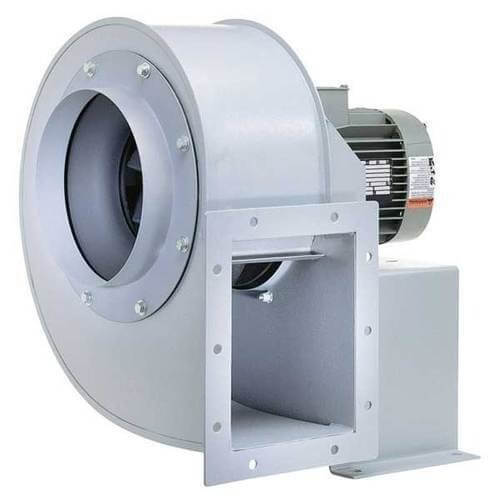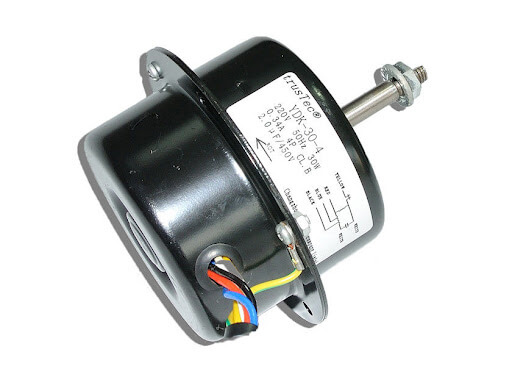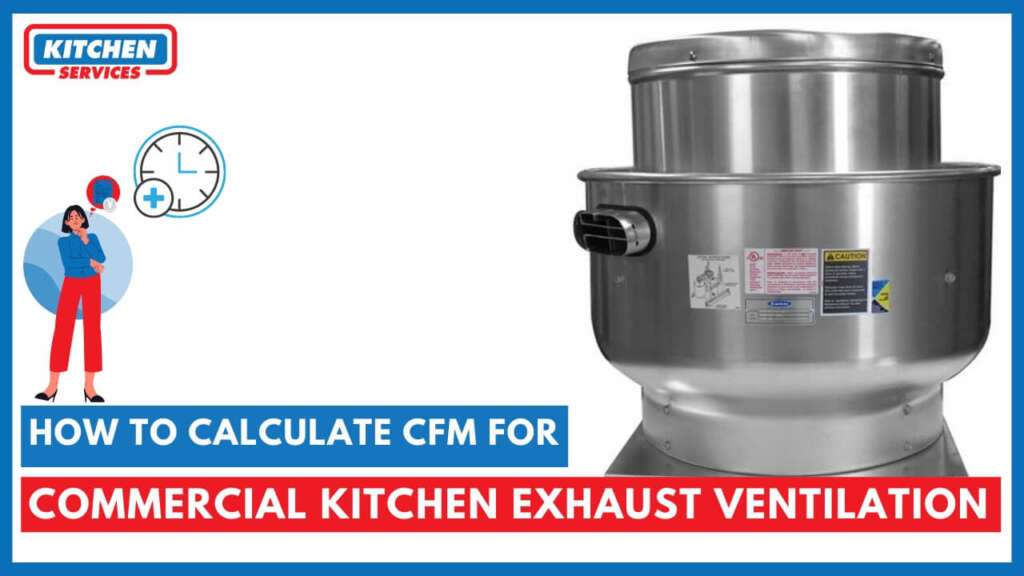So, the first question arises in the mind is what actually is the CFM for commercial kitchen exhaust fans? Well to explain this in detail read this article till the end for a better understanding.
The volume is actually the capacity of the compressor in order to press the air over a unit of time and it is measured in CFM (Cubic Feet Minute) which is basically the same as PCM (Cubic Feet per Minute) or l/min (liters per minute). 1 CFM is the acronym for 1 ft³/min = 1 ft³/min. Correspondingly, in order to convert cubic feet per minute (ft³/min) to cubic meters per hour (m³/h), you will have to multiply it by: 1.699.
In order to define the perfect size Grease Range Hood System to install, National Fire Code (NFC) imposes that your kitchen hood should be 6 inches larger on all four sides as compared to all of the kitchen equipment that is present under it. You can always consult with your local Building Code Office to understand if they require more extension or not. Additionally, do you know what is the proper way to calculate fresh air CFM? So basically, let’s suppose 20% of the total airflow of the system is being pulled into the system from outside. Next, in order to find the fresh CFM, multiply the percentage of fresh air by the fan airflow. Let’s assume we have a 3-ton system moving 1,200 CFM. You will then Multiply the 20% fresh air by the 1,200 CFM to find a fresh air CFM of 240.
How much CFM do I need for my range hood?
On average, a range hood fan must move at a minimum of 100 CFM of air for about every 12 inches of the stove width. This actually determines that in case you have a stove that is 30 inches wide then you will need a range hood with a fan that rotates for at least 250 CFM of air.
Other than these particular instructions that will be given to you at different sections, you should always keep this thing in mind that you should never use commas. For instance, you will have to write 20000 and not 20,000. Feel free to always use decimal points if required. All sections do not have to be filled, but within a section fill in all the required information, otherwise, you are going to get the wrong results.
Kitchen Services handle all your kitchen hood installation requirements – from consulting and designs to getting the required permits, installation, and final inspection. Call our experts in Los Angeles and around.
Instructions for calculating the CFM for Commercial Kitchen Exhaust fans

1. You can begin by measuring the dimensions of your kitchen. It is very important to have an accurate length, width, and height of the area that the kitchen hood will be installed. Define the volume of air inside your commercial kitchen by multiplying the three figures together.
Let’s suppose that the kitchen is 8 feet wide by 10 feet long by 8 feet high, which is equal to 640 cubic feet of air. The fan will have to move at least 15 times in an hour, so you can multiply the amount of air (640 cubic feet) by 15 to get a total of 9600 cubic feet of air. The CFM is always measured in minutes, so now you will have to divide that number by 60. Divide 9600 by 60 to get 160 CFM as the starting point for the CFM hood rating.
2. you will then have to determine the number of BTUs (British thermal units — the standard measurement for range size) which is produced by your range and add 100CFM per 10,000 BTU’s. In the example given above, it uses a range of 20,000 BTUs which is located directly under the kitchen hood. Consequently, you will have to add 200 CFM to the original chapel CFM number (160+200CFM) for a total of 360 CFM to be accepted.
3. you can then measure the length of the pipe so that the exhaust hood will prevail over the old air. You will then have to use the values in the resource table and establish the exact length of the duct. In the example, you have a single controlled duct that is 4 feet of 6-inch pipe directly to a 90-degree elbow, within 10 feet of straight pipe and a cap.
This one is calculated this way: 7 feet of straight pipe + 20 feet for the elbow + 40 meters for the cap = 67CFM. You can then add the result to the total CFM (360 CFM + 67CFM) in order to get a calculated CFM rating for the 472CFM bell. In order to be consistent, you will have to install a fan in the kitchen hood that has been rated at least 430 CFM or may be higher.
CFM Calculation Formula

CFM = area x Height ceiling x ACH / 60
CFM calculator for commercial kitchen
By using commercial kitchen hood CFM calculator, this is another much easier method to calculate the CFM of a kitchen hood: CFM is equal to the area of the hood in (square feet) multiplied by 90.
CFM= hood area x 90
For example:
If you have a hood that measures 4′ x 7′, the calculation to know the CFM would be as follows:
4′ x 7′ = 28 P2
28 x 90= 2,520 CFM
These are mainly recommendations that are based on the HVI and you are easy to pick that is based on your personal judgment as well. In a lot of municipalities, if you choose to install a range hood with a CFM greater than 400, you may also be required to include the makeup air. So, you can look into your local rules and regulations and decide yourself what CFM would be best for your commercial kitchen, using the output from the calculator as a guideline.
How Many CFM Per Square Foot?
So basically, among many questions regarding CFM, one of the most commonly asked questions is how many CFM airflow do we need per sq ft. Apparently, that only depends on the ceiling height and ACH. If we predispose 8 ft ceiling height, you can calculate CFM per sq ft for different values of ACH:
- 0.13 CFM per square foot at ACH = 1.
- 0.27 CFM per square foot at ACH = 2.
- 0.40 CFM per square foot at ACH = 3.
- 0.53 CFM per square foot at ACH = 4.
- 0.67 CFM per square foot at ACH = 5.
ACH is very vital for air purifiers, for instance. All those people that are allergy-prone will take the most benefit from the best H13 HEPA air purifiers for allergies. The exposure area of those units needs to be calculated for 5 ACH. On the other side, even the best air purifiers for any sort of mold will demand at most 4 ACH. In practice, the coverage area of these units is calculated at 2 ACH.
Commercial Kitchen Exhaust Fan Installation Guide
How do you size a kitchen exhaust fan?
In order to find the fan that is needed for your size kitchen, multiply the number of cubic feet in the room by the number of air exchanges (15), then divide it by the number of minutes in an hour that is (60).
Is 400 cfm enough for range hood?
To power your range hood, you need at least 100 CFM for every 10,000 BTUs of your stovetop. For example, a 100,000 BTU stove needs at least a 1000 CFM range hood. For electric stoves, multiply the stove width by 10. So, for a 42” electric stove you want a range hood with at least 420 CFM
How many CFM do I need in a commercial kitchen?
Spaces containing cooking appliances that do not require Type II hoods shall be provided with exhaust at a rate of 0.70 cfm per square foot
What is the minimum duct size for a range hood?
The minimum recommended duct size is 6” for 0-400 CFM range hoods. The smaller the duct size, the less CFM you need. The larger the duct size, the more CFM you need.
What is the difference between SCFM and CFM?
SCFM, or standard cubic feet per minute, is a CFM measurement based on a standard temperature, pressure, and humidity. CFM, on the other hand, does not take variables like temperature and pressure into account. For this reason, it is a slightly less accurate measurement of fan power. That being said, most range hoods are measured in CFM while air tools use SCFM.
How much CFM do I need for an air compressor?
Most air compressors power air tools between 70 pounds per square inch (PSI) and 120 PSI. The smaller the air tool, the less CFM your air compressor requires. A 10 CFM air compressor will work for most people, however, some of the larger tools require 15 CFM or more.
We hope this commercial kitchen hood exhaust calculation will help you in future Kitchen Hood Installations. Be sure to always discuss this with your contractor HVAC installers and appliance providers.
Kitchen Services, provide turnkey restaurant kitchen hood installation services in Los Angeles and around so that you no longer have to worry about the many aspects of the kitchen exhaust system installation process.

